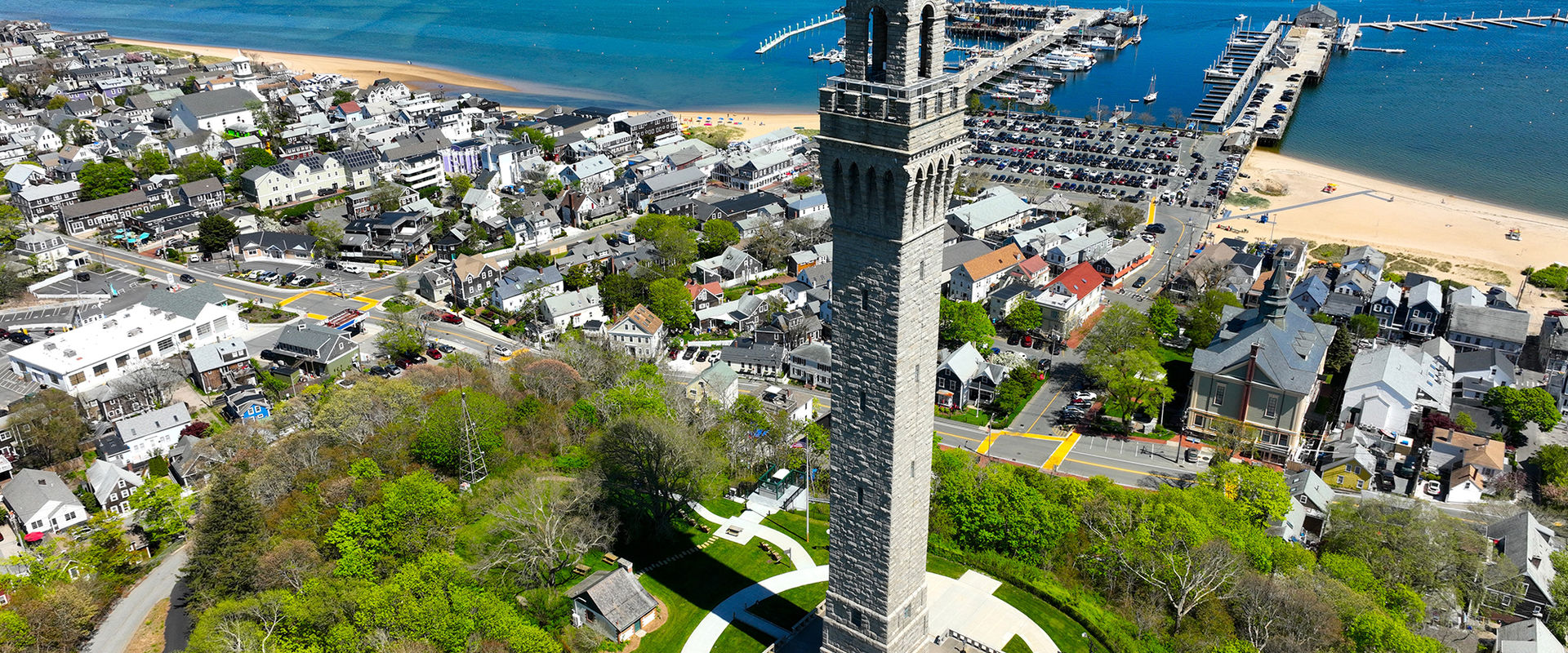


Linking Downtown Provincetown and The Pilgrim Monument via an Inclined Elevator
Reinforcing the Beloved Landmark with State-of-the-Art Polymer Fiber Exoskeleton System While Respecting Its Historic Authenticity
The Pilgrim Monument and Museum (PMPM) is Cape Cod’s oldest cultural institution and the symbol of Provincetown. Rising 350 feet above sea level, the Monument was built in the early 1900s to commemorate the landing of the Mayflower pilgrims and signing the first governance document in the New World - the Mayflower Compact.
The monument is located on a very steep 80 feet tall High Pole Hill, which acts as a visual and physical barrier to monument and museum. The isolation from the downtown and the lack of accessibility have bothered both locals and tourists for year, causing confusion and preventing the back-and- forth foot traffic between the busy downtown and the monument. With 2020 marking 400th anniversary of the pilgrims’ landing, the PMPM Trustees decided to move forward on a grand plan to connect the PMPM to the rest of the town as an ongoing legacy of the historic site.
The inclined elevator is a custom-designed single tram system (as opposed to a “funicular”, which is a dual tram system that counts on the opposing cab for counterweight). The tram will run on a track between two 20 ft by 20 ft ADA-compliant pavilions at a speed of approximately 200 feet per minute. It will be able to transport up to 18 passengers in about two minutes.
As engineers of record, Coastal Engineering has developed a civil engineering design for the grounds, structural engineering design for the rail support foundation system, and assisted with the permitting process. The planning process started started with assessing the environmental aspects. The outer Cape surficial geology is essentially a giant sand dune formed from the post glacial deposition of sand and silt from the last advance and retreat of the ice sheet. As such, slope stability and the integrity of the rail support structure were the main considerations of the project.
Helical piles installed about 45 ft deep will reinforce the loose sand and increase the global stability of the site. There are four helical piles comprised of a lead section with three helix bearing plates followed by plain 2-7/8 inch diameter extension pieces. They will be installed at an angle, serving as tiebacks for the tension load from the mechanism itself. A pair of helicals down the rails approximately every 12 feet on center will act as the frames to hold up the rails in between. Both the platform foundation and the rail ties are supported on helicals as well. Accurate X, Y, and Z placement of pier supporting the tram rails was critical for the success for the design and construction of the inclined elevator.
The mechanism and hoist for the elevator will be located at the top of the hill. The piers and upper pavilion and rail foundations have been designed to enable the hoist mechanism to pull the elevator up the hill without affecting the stability of the nearby Pilgrim Monument.
The lower pavilion is located in a mapped flood zone (AE EL=10) and has the landing at the Base Flood Elevation, however, the elevator pit is located below grade to house some of the elevator mechanisms. As such, the elevator pit had to be designed for both the high ground water levels and for hydrostatic flood forces on the structure. To install the elevator pit, a sheet pile cofferdam enclosure was built, dewatered, and then fitted with a precast concrete box that was also anchored with helical piles to form the lower section of the elevator pit, Bologna says.
The coordination of structural components with the mechanical components were particularly challenging. Specifically, accommodating the precisions demanded by the machinery while understanding civil and structural construction tolerances and anticipated structural deflections.
Prior to the inclined elevator project, Coastal Engineering was engaged as the Engineer of Record to evaluate, design, and execute a comprehensive restoration and renovation of the monument’s interior structure. The Monument was designed to resemble Torre Del Mangia in Sienna, Italy, and built of steel, mortar, and granite from Stonington, ME. After a century of salt air and foot traffic, it was time for a renovation. While granite is virtually indestructible, sections of concrete embedded with steel had absorbed moisture and salt spray, causing the steel to corrode and disintegrate. In conjunction with Fibrwrap Construction Services Inc., a state-of-the-art advanced polymer fiber technology pioneered in aerospace industry was used to reinforce the structure with a moisture-proof exoskeleton system - all while respecting the monument’s historic authenticity. Also included in the project was variance with Architectural Access Board for universal access alternatives. New handrails and tempered glass panels were added, allowing panoramic 360-degree views of Cape Cod Bay and the Atlantic Ocean. The job was done with minimal interruption to the public and the facility’s revenue stream.